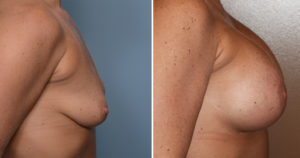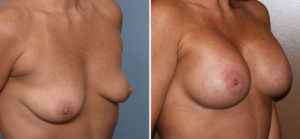Background: Many women that present for breast augmentation surgery do not have perfectly symmetric breasts. Women that have never had breast implant surgery rarely have symmetric breasts either. Yet, understandably, the woman who undergoes elective aesthetic breast surgery seeks the most symmetric result possible.
Of all the aesthetic breast deformities that exist, asymmetry is the most common and comes in many forms. The breast mound may be smaller on one side, there may be more sagging on one breast versus the other and/or the nipple may be lower. Since every women has some degree of asymmetry it behooves the surgeon and the patient to take careful note of it before surgery when a plan for intraoperative management can be done.
Differences in the horizontal level of the nipple is a very important asymmetry to note before surgery as breast augmentation will almost always make it worse. It is also often correctable by an adjustment done directly on the nipple. Known as a superior crescent mastopexy (SCM), ity is better referred to as a superior nipple lift. The superior half of the lower nipple can be lifted upward by about a centimeter or so through a crescent-shaped skin excision pattern.
Case Study: This 36 year-old female wanted a better breast shape. She was aware of her breast asymmetry with the right breast being bigger with greater skin sag and a resultant lower nipple position.


Highlights:
- Breast asymmetry is the most common ‘deformity’ in prospective breast augmentation patients.
- Implants alone can not be counted on for correcting breast size or shape issues.
- A superior nipple lift on the more ‘saggy’ breast side during breast augmentation can help correct asymmetry.
Dr. Barry Eppley
Indianapolis, Indiana



